-
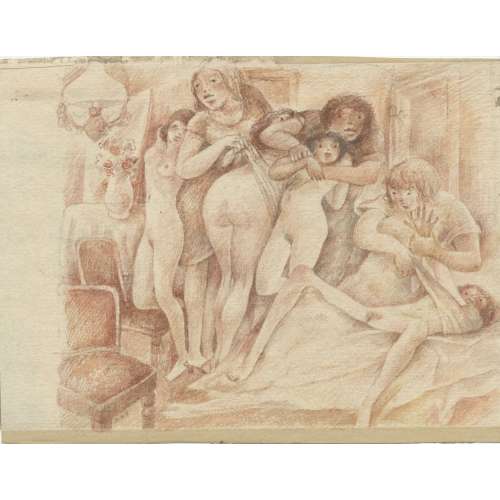 Watercolour, pen and ink on thick wove paper, 177 x 235 mm; to verso: blue ink stamp “Nachlaß O R SCHATZ" and fuchsia ink stamp ARS EROTICA | Hans-J. Döpp; traces of framing along all the margins; traces of framing along the margins; remains of hinges. Artist: Otto Rudolf Schatz (Austrian, 1900 – 1961).
Watercolour, pen and ink on thick wove paper, 177 x 235 mm; to verso: blue ink stamp “Nachlaß O R SCHATZ" and fuchsia ink stamp ARS EROTICA | Hans-J. Döpp; traces of framing along all the margins; traces of framing along the margins; remains of hinges. Artist: Otto Rudolf Schatz (Austrian, 1900 – 1961). -
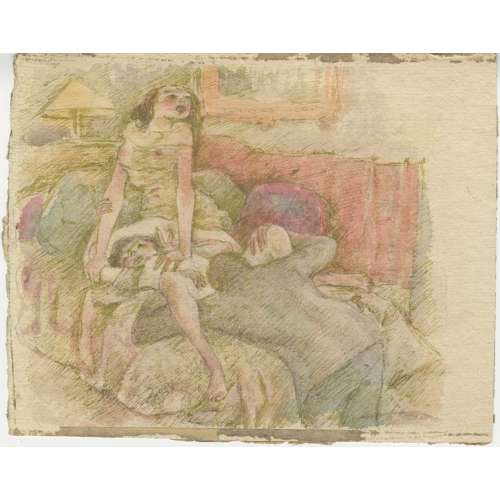 Watercolour, pen and ink on thick wove paper, 180 x 220 mm; to verso: blue ink stamp “PROF O. R. SCHATZ | Wien II, Gr. Mohreng 3b | Tel.: 55 82 566”; fuchsia ink stamp "ARS EROTICA | Hans-J. Döpp"; traces of framing along the margins. Artist: Otto Rudolf Schatz (Austrian, 1900 – 1961).
Watercolour, pen and ink on thick wove paper, 180 x 220 mm; to verso: blue ink stamp “PROF O. R. SCHATZ | Wien II, Gr. Mohreng 3b | Tel.: 55 82 566”; fuchsia ink stamp "ARS EROTICA | Hans-J. Döpp"; traces of framing along the margins. Artist: Otto Rudolf Schatz (Austrian, 1900 – 1961). -
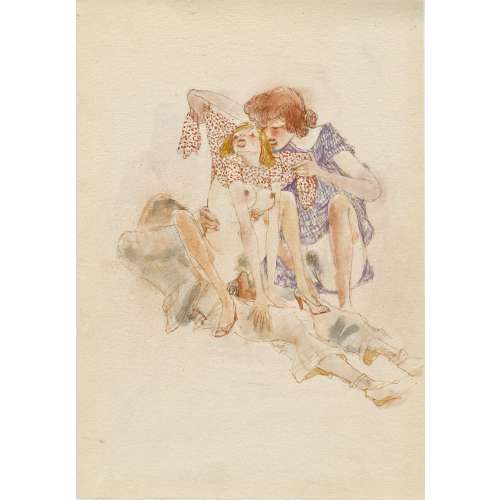 Watercolour on thick wove paper, unsigned. Attributed to Otto Rudolf Schatz (Austrian, 1900 – 1961). Size: 305 x 212 mm.
Watercolour on thick wove paper, unsigned. Attributed to Otto Rudolf Schatz (Austrian, 1900 – 1961). Size: 305 x 212 mm. -
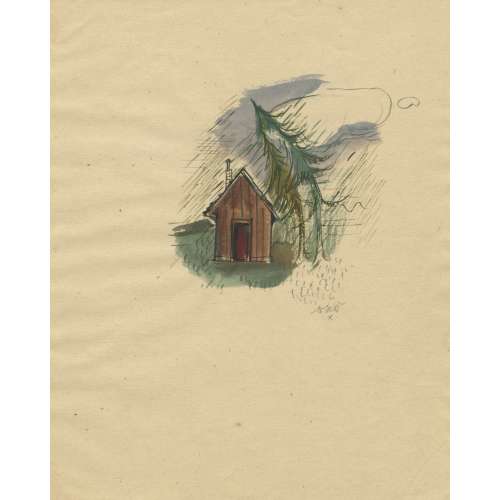 NEWCardboard clamshell box of red buckram over marbled paper 360 x 260 mm, contains 13 drawings (watercolour and pen on paper), wove paper sheets approx. 220 x 190 mm, title page mounted on a blank sheet and monogrammed 'ORS", others in passe-partout 350 x 250 mm, unsigned. Artist: Otto Rudolf Schatz (Austrian, 1900 – 1961).
NEWCardboard clamshell box of red buckram over marbled paper 360 x 260 mm, contains 13 drawings (watercolour and pen on paper), wove paper sheets approx. 220 x 190 mm, title page mounted on a blank sheet and monogrammed 'ORS", others in passe-partout 350 x 250 mm, unsigned. Artist: Otto Rudolf Schatz (Austrian, 1900 – 1961). -
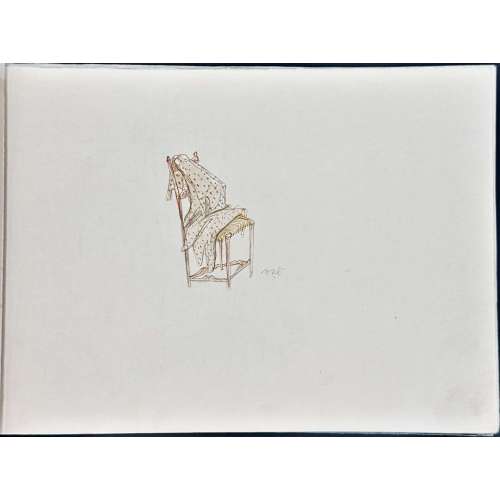 Japanese-style bound oblong horizontal album of 20 colour drawings (watercolour and pencil on paper), 187 x 269 mm, monogrammed on the first page ORS, signed and dated on the last page O. R. SCHATZ | 1954 | x || Artist: Otto Rudolf Schatz (Austrian, 1900 – 1961).
Japanese-style bound oblong horizontal album of 20 colour drawings (watercolour and pencil on paper), 187 x 269 mm, monogrammed on the first page ORS, signed and dated on the last page O. R. SCHATZ | 1954 | x || Artist: Otto Rudolf Schatz (Austrian, 1900 – 1961). -
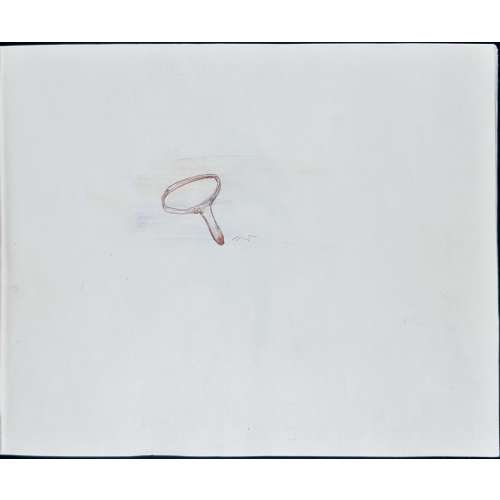 NEWAlbum of 17 watercolour drawings on thick wove paper sheets 265 x 205 mm, incl. title and colophon, in Japanese stab binding — cardboard covers with yellow and grey stripes sewed with pink thread. Signed and dated. The conditional title of the album may be "Girl's Toy". Artist: Otto Rudolf Schatz (Austrian, 1900 – 1961).
NEWAlbum of 17 watercolour drawings on thick wove paper sheets 265 x 205 mm, incl. title and colophon, in Japanese stab binding — cardboard covers with yellow and grey stripes sewed with pink thread. Signed and dated. The conditional title of the album may be "Girl's Toy". Artist: Otto Rudolf Schatz (Austrian, 1900 – 1961). -
 NEWTwelve drypoint plates, incl. the title, with plate marks at 90 x 70 mm, unsigned, in Japanese style binding — sewed cardboard covers with blue and green diaper design 195 x 142 mm; blank fly leaves in the front and the rear. Dorotheum GmbH selling slip laid in. The number of printed copies is unknown to us. Artist: Otto Rudolf Schatz (Austrian, 1900 – 1961).
NEWTwelve drypoint plates, incl. the title, with plate marks at 90 x 70 mm, unsigned, in Japanese style binding — sewed cardboard covers with blue and green diaper design 195 x 142 mm; blank fly leaves in the front and the rear. Dorotheum GmbH selling slip laid in. The number of printed copies is unknown to us. Artist: Otto Rudolf Schatz (Austrian, 1900 – 1961). -
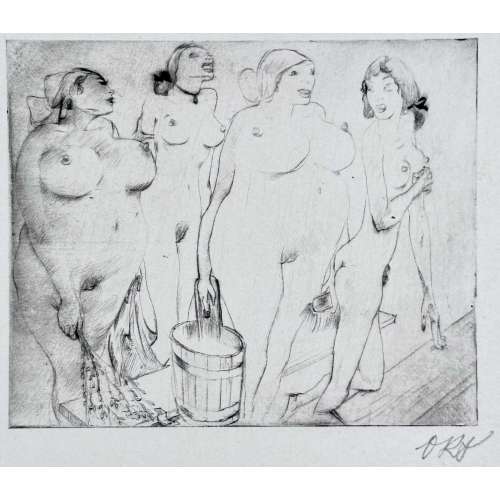 NEWDrypoint on cream cardstock 208 x 207 mm with platemark 100 x 122 mm, monogrammed "ORS" in pencil outside the plate. Artist: Otto Rudolf Schatz (Austrian, 1900 – 1961).
NEWDrypoint on cream cardstock 208 x 207 mm with platemark 100 x 122 mm, monogrammed "ORS" in pencil outside the plate. Artist: Otto Rudolf Schatz (Austrian, 1900 – 1961). -
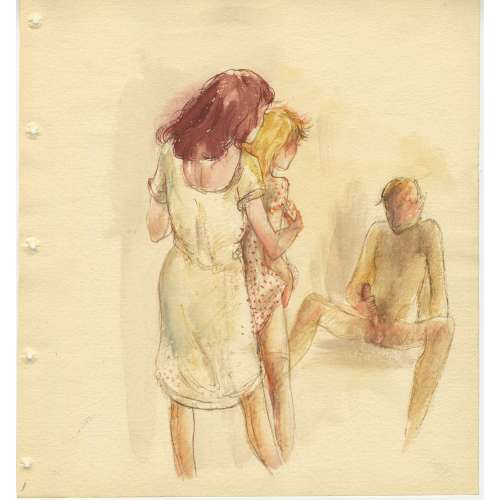 NEWEleven loose sheets, approx. 250 x 230 mm each, numbered in the bottom left corner in pencil (by owner?), with five binding holes in the left margin, traces of passe-partout mounting to verso; no title sheet. It is probably a disbound watercolour album telling the same story as the printed Der Kleine Bruder (see SVE-0581.2024). Artist: Otto Rudolf Schatz (Austrian, 1900 – 1961).
NEWEleven loose sheets, approx. 250 x 230 mm each, numbered in the bottom left corner in pencil (by owner?), with five binding holes in the left margin, traces of passe-partout mounting to verso; no title sheet. It is probably a disbound watercolour album telling the same story as the printed Der Kleine Bruder (see SVE-0581.2024). Artist: Otto Rudolf Schatz (Austrian, 1900 – 1961). -
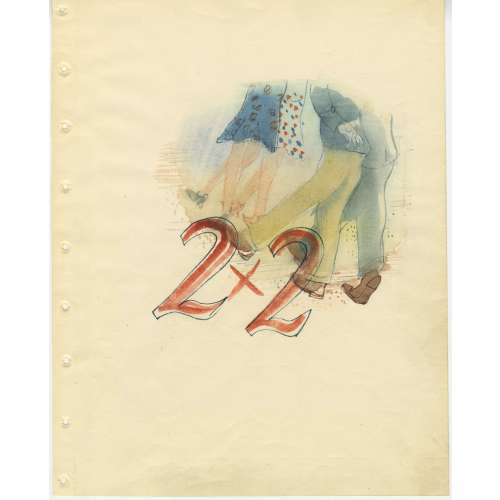 NEWTwo loose sheets, one 295 x 235 mm and another, the title page, 295 x 470 mm, folded in half with the image on one side only, leaves pierced for being bound in an album. Artist: Otto Rudolf Schatz (Austrian, 1900 – 1961).
NEWTwo loose sheets, one 295 x 235 mm and another, the title page, 295 x 470 mm, folded in half with the image on one side only, leaves pierced for being bound in an album. Artist: Otto Rudolf Schatz (Austrian, 1900 – 1961). -
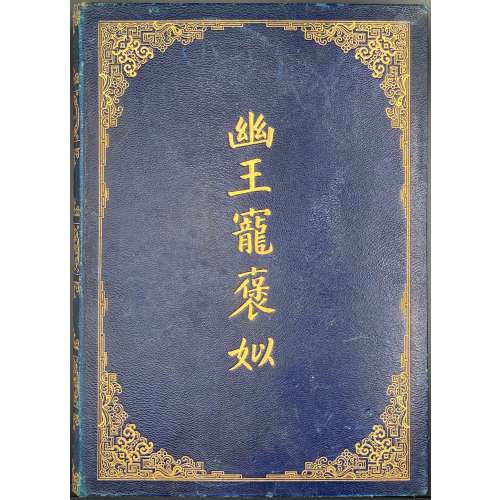 Description: Hardcover, in-folio, 32 x 23.5 cm, bound in dark blue morocco, boards and spine richly decorated in gilt, front cover gilt-lettered in Chinese [幽王寵褒姒], pictorial endpapers, laid paper with unicorn watermark, margins uncut, printing performed by Joh. Enschedé (Haarlem), pp. [10] 1-210 [6], total 226 pages, collated π5 1-532 χ2, first and last leaves blank, total 113 leaves plus 7 plates after Franz von Bayros, some signed; adorned with woodcut borders, frames, head- and tailpieces throughout. The binding work was done by Hübel und Denck (Leipzig) based on designs by Paul Renner. Title-page: DAS | SCHÖNE | MÄDCHEN | VON PAO | — | EIN CHINESISCHER | ROMAN VON | OTTO JULIUS BIERBAUM | — | PRACHTAUSGABE | MIT BILDERN VON BAYROS | — | Bei Joh. Enschedé en Zonen in | Haarlem gedruckt für Georg | Müllers Verlag in München || Catalogue raisonné: The amorous drawings of the Marquis von Bayros. — New York: Cythera Press, 1968. The Beautiful Maiden of Pao, pp. 153-8. Contributors: Otto Julius Bierbaum (German, 1865 – 1910) – author. Franz von Bayros (Austrian, 1866 – 1924) – artist. Johannes Enschedé (Dutch, 1708 – 1780) – printer. Joh. Enschedé (Haarlem) – printer. Hübel und Denck (Leipzig) – bookbinder. Paul Friedrich August Renner (German, 1878 – 1956) – designer.
Description: Hardcover, in-folio, 32 x 23.5 cm, bound in dark blue morocco, boards and spine richly decorated in gilt, front cover gilt-lettered in Chinese [幽王寵褒姒], pictorial endpapers, laid paper with unicorn watermark, margins uncut, printing performed by Joh. Enschedé (Haarlem), pp. [10] 1-210 [6], total 226 pages, collated π5 1-532 χ2, first and last leaves blank, total 113 leaves plus 7 plates after Franz von Bayros, some signed; adorned with woodcut borders, frames, head- and tailpieces throughout. The binding work was done by Hübel und Denck (Leipzig) based on designs by Paul Renner. Title-page: DAS | SCHÖNE | MÄDCHEN | VON PAO | — | EIN CHINESISCHER | ROMAN VON | OTTO JULIUS BIERBAUM | — | PRACHTAUSGABE | MIT BILDERN VON BAYROS | — | Bei Joh. Enschedé en Zonen in | Haarlem gedruckt für Georg | Müllers Verlag in München || Catalogue raisonné: The amorous drawings of the Marquis von Bayros. — New York: Cythera Press, 1968. The Beautiful Maiden of Pao, pp. 153-8. Contributors: Otto Julius Bierbaum (German, 1865 – 1910) – author. Franz von Bayros (Austrian, 1866 – 1924) – artist. Johannes Enschedé (Dutch, 1708 – 1780) – printer. Joh. Enschedé (Haarlem) – printer. Hübel und Denck (Leipzig) – bookbinder. Paul Friedrich August Renner (German, 1878 – 1956) – designer. -
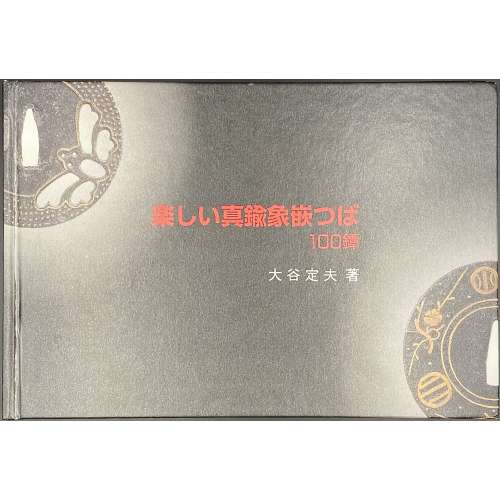 Description: Hardcover oblong volume 16 x 23.3 cm with black pictorial paper boards lettered in red and white to front cover and spine, in an ochre slipcase sprinkled brown and lettered in black to front and spine; grey endpapers, pp. [2] 3-130 [2], with a bookshop ticket to back pastedown “ISSHINDō”. Illustrated descriptions of 100 Japanese sword handguards (tsuba) with brass inlay. Title-page: 楽しい真鍮象嵌つば | 100 鐔 | 大谷定夫著 [Tanoshii Shinchū-Zōgan Tsuba | Hyakutan | Ōya Sadao cho] (Enjoying Brass Inlay Sword Guards | 100 Sword Guards | Author: Ōya Sadao) Colophon: Published December 15, 1999 Price: ¥3,800 (base price ¥3,619) Author: Ōya Sadao (大谷定夫) Producer: Ōtsuka Kōgeisha International Publisher: Ōtsuka Kōgeisha Co. Ltd. (大塚工藝社)Phone 103–0016 Tōkyō-to, Chūō-ku, Nihonbashi Koami-chō 1–5 Tel. 03–5642–3511 (Representative) Fax 03–5642–3618 Design: Takahashi Tōru (高橋享) Photography: Kitami Noboru (北見登) Kishioka Yasuhiro (岸岡保弘) ISBN4–900298–03–4 C0072 ¥3619E Subject: Ōnin tsuba; Heianjō tsuba; Suemon-zōgan; Ten-zōgan; Japanese sword handguards; Japanese sword fittings; Tosogu.
Description: Hardcover oblong volume 16 x 23.3 cm with black pictorial paper boards lettered in red and white to front cover and spine, in an ochre slipcase sprinkled brown and lettered in black to front and spine; grey endpapers, pp. [2] 3-130 [2], with a bookshop ticket to back pastedown “ISSHINDō”. Illustrated descriptions of 100 Japanese sword handguards (tsuba) with brass inlay. Title-page: 楽しい真鍮象嵌つば | 100 鐔 | 大谷定夫著 [Tanoshii Shinchū-Zōgan Tsuba | Hyakutan | Ōya Sadao cho] (Enjoying Brass Inlay Sword Guards | 100 Sword Guards | Author: Ōya Sadao) Colophon: Published December 15, 1999 Price: ¥3,800 (base price ¥3,619) Author: Ōya Sadao (大谷定夫) Producer: Ōtsuka Kōgeisha International Publisher: Ōtsuka Kōgeisha Co. Ltd. (大塚工藝社)Phone 103–0016 Tōkyō-to, Chūō-ku, Nihonbashi Koami-chō 1–5 Tel. 03–5642–3511 (Representative) Fax 03–5642–3618 Design: Takahashi Tōru (高橋享) Photography: Kitami Noboru (北見登) Kishioka Yasuhiro (岸岡保弘) ISBN4–900298–03–4 C0072 ¥3619E Subject: Ōnin tsuba; Heianjō tsuba; Suemon-zōgan; Ten-zōgan; Japanese sword handguards; Japanese sword fittings; Tosogu. -
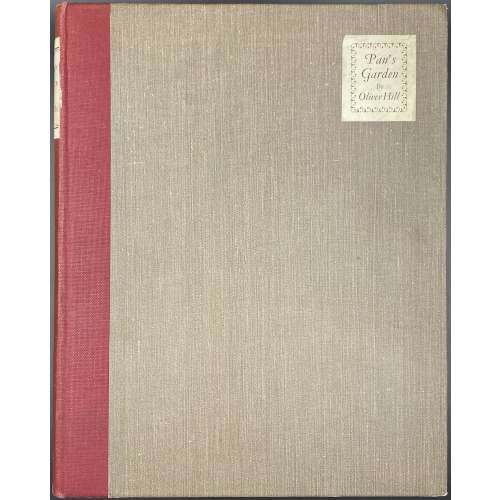 Description: Hardcover photographic pictorial album, 29.2 x 23.1 cm, quarter crimson percaline over grey cloth with lettered paper labels to front cover and spine, grey endpapers; pp. [1-4] 5-109 [3], total 56 leaves, additional spine and cover labels tipped-in. Oliver Hill (British, 1887 – 1968).
Description: Hardcover photographic pictorial album, 29.2 x 23.1 cm, quarter crimson percaline over grey cloth with lettered paper labels to front cover and spine, grey endpapers; pp. [1-4] 5-109 [3], total 56 leaves, additional spine and cover labels tipped-in. Oliver Hill (British, 1887 – 1968). -
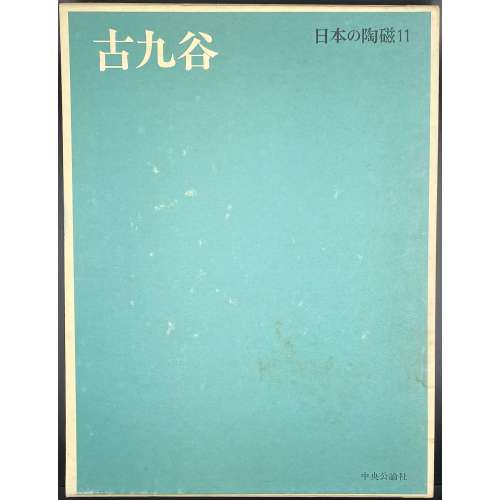 Hardcover volume, 35 x 26.8 cm, bound in grey cloth, blind stamped characters to front, brown characters to spine, in a slipcase, the outer case missing, pp.: [4] [1] 2-136 (plates with photographs of 211 items), [2] 139-166 [4]. Kutani ware [九谷焼] (Kutani-yaki); old kutani [古九谷] (kokutani) – ceramic objects produced in Kutani in the 17th century. 日本の陶磁 – Japanese ceramics, series title. Contributors: Yasunari Kawabata [川端 康成] (Japanese, 1924 – 1972) – author. Tetsuzo Tanikawa [谷川 徹三] (Japanese, 1895 – 1989) – author. Seizo Hayashiya [林屋晴三] (Japanese, 1928 – 2017) – editor. Chūōkōron-sha [中央公論社] – publisher.
Hardcover volume, 35 x 26.8 cm, bound in grey cloth, blind stamped characters to front, brown characters to spine, in a slipcase, the outer case missing, pp.: [4] [1] 2-136 (plates with photographs of 211 items), [2] 139-166 [4]. Kutani ware [九谷焼] (Kutani-yaki); old kutani [古九谷] (kokutani) – ceramic objects produced in Kutani in the 17th century. 日本の陶磁 – Japanese ceramics, series title. Contributors: Yasunari Kawabata [川端 康成] (Japanese, 1924 – 1972) – author. Tetsuzo Tanikawa [谷川 徹三] (Japanese, 1895 – 1989) – author. Seizo Hayashiya [林屋晴三] (Japanese, 1928 – 2017) – editor. Chūōkōron-sha [中央公論社] – publisher. -
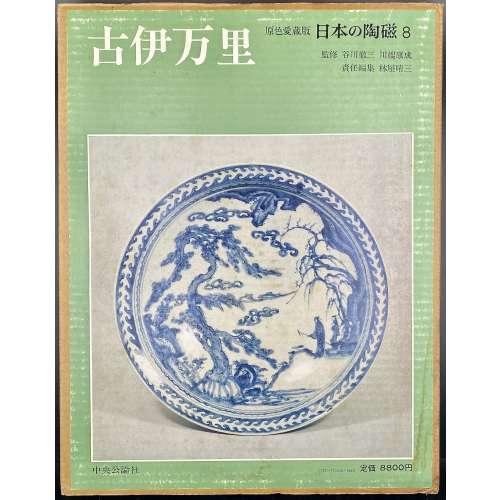 Hardcover volume, 35.1 x 27 cm, bound in grey cloth, blind stamped characters to front, brown characters to spine, in a glassine dust jacket, in a double slipcase, the outer case pictorial paper over cardboard, 36 x 27.8 cm, pp.: [4] [1] 2-108 (plates with photographs of 217 items), [2] [111] 112-150 [3]. Imari ware [伊万里焼] (Imari-yaki) – ceramics produced in and around the area of Arita, in the former Hizen Province, northwestern Kyūshū. 日本の陶磁 – Japanese ceramics, series title. Old imari [古伊万里] (koimari) – book title. Contributors: Yasunari Kawabata [川端 康成] (Japanese, 1924 – 1972) – author. Tetsuzo Tanikawa [谷川 徹三] (Japanese, 1895 – 1989) – author. Seizo Hayashiya [林屋晴三] (Japanese, 1928 – 2017) – editor. Chūōkōron-sha [中央公論社] – publisher.
Hardcover volume, 35.1 x 27 cm, bound in grey cloth, blind stamped characters to front, brown characters to spine, in a glassine dust jacket, in a double slipcase, the outer case pictorial paper over cardboard, 36 x 27.8 cm, pp.: [4] [1] 2-108 (plates with photographs of 217 items), [2] [111] 112-150 [3]. Imari ware [伊万里焼] (Imari-yaki) – ceramics produced in and around the area of Arita, in the former Hizen Province, northwestern Kyūshū. 日本の陶磁 – Japanese ceramics, series title. Old imari [古伊万里] (koimari) – book title. Contributors: Yasunari Kawabata [川端 康成] (Japanese, 1924 – 1972) – author. Tetsuzo Tanikawa [谷川 徹三] (Japanese, 1895 – 1989) – author. Seizo Hayashiya [林屋晴三] (Japanese, 1928 – 2017) – editor. Chūōkōron-sha [中央公論社] – publisher. -
 Description: In-8vo volume, 19.4 x 14 cm, bound in red cloth with gilt lettering to front cover and spine, in a pictorial dust jacket with a photo portrait of the author by Kay Bell to the rear, DJ and in-text illustrations by Maurice Sendak; pp. [i-x] xi-xvii [xviii] [2] 3-190, total 208 pages. Dust Jacket front: You Can't | Get There | From Here | {vignette} | OGDEN NASH || Title-page: OGDEN NASH | You Can't Get There | From Here | {vignettes} | DRAWINGS BY MAURICE SENDAK | Boston • LITTLE, BROWN AND COMPANY • Toronto || Edition: 1957, 8th printing; (1st edition in 1953) Contributors: Ogden Nash (American, 1902 – 1971) – author. Maurice Sendak (Jewish-American, 1928 – 2012) – artist. Kay Bell Reynal (American, 1905 – 1977) – photographer.
Description: In-8vo volume, 19.4 x 14 cm, bound in red cloth with gilt lettering to front cover and spine, in a pictorial dust jacket with a photo portrait of the author by Kay Bell to the rear, DJ and in-text illustrations by Maurice Sendak; pp. [i-x] xi-xvii [xviii] [2] 3-190, total 208 pages. Dust Jacket front: You Can't | Get There | From Here | {vignette} | OGDEN NASH || Title-page: OGDEN NASH | You Can't Get There | From Here | {vignettes} | DRAWINGS BY MAURICE SENDAK | Boston • LITTLE, BROWN AND COMPANY • Toronto || Edition: 1957, 8th printing; (1st edition in 1953) Contributors: Ogden Nash (American, 1902 – 1971) – author. Maurice Sendak (Jewish-American, 1928 – 2012) – artist. Kay Bell Reynal (American, 1905 – 1977) – photographer. -
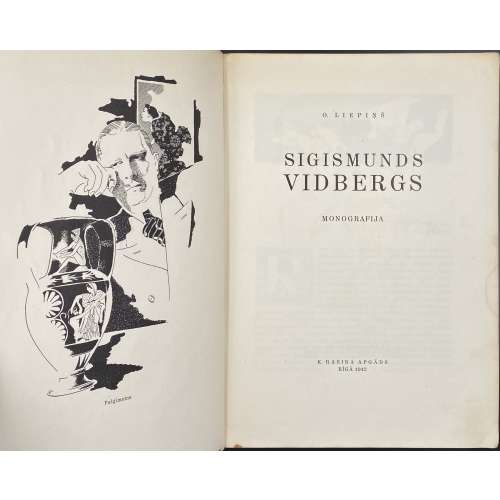 Publisher’s original wrappers, with VIDBERGS to front (bordered) and to spine, size 25 x 18 cm. Title page: O. LIEPIŅŠ | SIGISMUNDS | VIDBERGS | MONOGRAFIJA | K. RASIŅA APGĀDS | RIGĀ 1942 || Imprint: ATTĒLI MĀKSLINIEKA IZRAUDZĪTI UN SAKĀRTOTI (pictures selected and arranged by the artist) Pagination: [1-6] (incl. 1st blank leaf), 7-149 [150] [2] blank; 44 pages of text with in-text illustrations, pp. 47-149 – plates on odd pages, titles on even pages, 51 full-page illustrations. Circulation: 4,000 copies. Contributors: Liepiņš, Olģerts (Latvian, 1906 – 1983) – author. Sigismunds Vidbergs (Latvian-American, 1890 – 1970) – artist. Kārlis Rasiņš (Latvian, 1886 – 1974) – publisher.
Publisher’s original wrappers, with VIDBERGS to front (bordered) and to spine, size 25 x 18 cm. Title page: O. LIEPIŅŠ | SIGISMUNDS | VIDBERGS | MONOGRAFIJA | K. RASIŅA APGĀDS | RIGĀ 1942 || Imprint: ATTĒLI MĀKSLINIEKA IZRAUDZĪTI UN SAKĀRTOTI (pictures selected and arranged by the artist) Pagination: [1-6] (incl. 1st blank leaf), 7-149 [150] [2] blank; 44 pages of text with in-text illustrations, pp. 47-149 – plates on odd pages, titles on even pages, 51 full-page illustrations. Circulation: 4,000 copies. Contributors: Liepiņš, Olģerts (Latvian, 1906 – 1983) – author. Sigismunds Vidbergs (Latvian-American, 1890 – 1970) – artist. Kārlis Rasiņš (Latvian, 1886 – 1974) – publisher. -
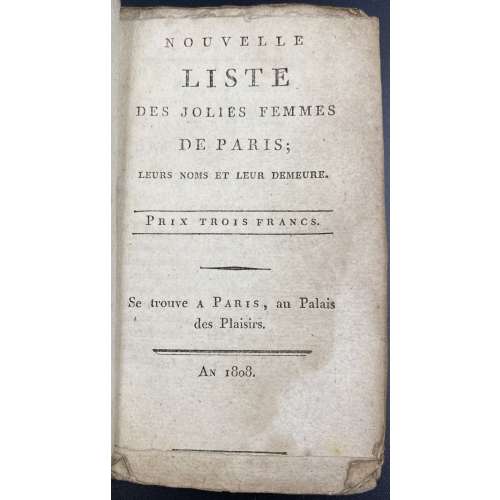 Title: NOUVELLE | LISTE | DES JOLIES FEMMES | DE PARIS ; | LEURS NOMS ET LEUR DEMEURE. | PRIX TROIS FRANCS. | Se trouve A Paris , au Palais des plaisirs. | — | An 1808. || Pagination : [1-6] 7-70 [2 blank] Collation : 9vo, [A]9 B-D9. Binding: Original blue wrappers, 15 x 9 cm. Ref: OCLC finds only one copy, at the British Library. The BnF has a work of the same title, with the same pagination, dated 1803. The stated publisher seems to be fictitious. Quaritch description: 12mo, pp. 70; a little dusty, a few spots and marks; a very good uncut copy in original blue/grey wrappers; somewhat worn and stained. Very rare guide to Parisian prostitutes providing an extraordinary snapshot of the state of prostitution in the city during the First French Empire. The anonymous compiler begins with a brief history of prostitution in the capital, and its regulation, under Charlemagne and Louis VIII, describes a brothel established by Joanna I of Naples at Avignon and discusses Pierre-Jean Grosley’s estimate of the number of prostitutes in London. He then provides his liste, divided into categories including ‘houses of the first order’, ‘bawdy houses’, ‘actresses’, ‘washerwomen’, and ‘procuresses’, giving the name of each prostitute, an indication of their age, and their physical attributes, character, and particular talents. Rosanne, for example, chez Madame l’Évêque at the Palais du Tribunat, offers ‘unspeakably voluptuous pleasures to the nether regions’; Honorine prefers women; Scholastique likes wine with her lovemaking; Nanette has a penchant for soldiers; Genevieve favours the priapic; Dorsay enjoys S&M, and Madame Laperriere promises rejuvenation to the elderly. One Ducroisy is poetically described as possessing ‘a tuft as black as a crow above two alabaster columns’, while Félicité has skin ‘soft and white, sprinkled with golden freckles, like gold in Maraschino liqueur’. The author hopes that his listed will bring business to the ladies and pleasure to their clients, beseeching both to look after their health so that his guide might ‘serve Love, not Asclepius’.
Title: NOUVELLE | LISTE | DES JOLIES FEMMES | DE PARIS ; | LEURS NOMS ET LEUR DEMEURE. | PRIX TROIS FRANCS. | Se trouve A Paris , au Palais des plaisirs. | — | An 1808. || Pagination : [1-6] 7-70 [2 blank] Collation : 9vo, [A]9 B-D9. Binding: Original blue wrappers, 15 x 9 cm. Ref: OCLC finds only one copy, at the British Library. The BnF has a work of the same title, with the same pagination, dated 1803. The stated publisher seems to be fictitious. Quaritch description: 12mo, pp. 70; a little dusty, a few spots and marks; a very good uncut copy in original blue/grey wrappers; somewhat worn and stained. Very rare guide to Parisian prostitutes providing an extraordinary snapshot of the state of prostitution in the city during the First French Empire. The anonymous compiler begins with a brief history of prostitution in the capital, and its regulation, under Charlemagne and Louis VIII, describes a brothel established by Joanna I of Naples at Avignon and discusses Pierre-Jean Grosley’s estimate of the number of prostitutes in London. He then provides his liste, divided into categories including ‘houses of the first order’, ‘bawdy houses’, ‘actresses’, ‘washerwomen’, and ‘procuresses’, giving the name of each prostitute, an indication of their age, and their physical attributes, character, and particular talents. Rosanne, for example, chez Madame l’Évêque at the Palais du Tribunat, offers ‘unspeakably voluptuous pleasures to the nether regions’; Honorine prefers women; Scholastique likes wine with her lovemaking; Nanette has a penchant for soldiers; Genevieve favours the priapic; Dorsay enjoys S&M, and Madame Laperriere promises rejuvenation to the elderly. One Ducroisy is poetically described as possessing ‘a tuft as black as a crow above two alabaster columns’, while Félicité has skin ‘soft and white, sprinkled with golden freckles, like gold in Maraschino liqueur’. The author hopes that his listed will bring business to the ladies and pleasure to their clients, beseeching both to look after their health so that his guide might ‘serve Love, not Asclepius’.


